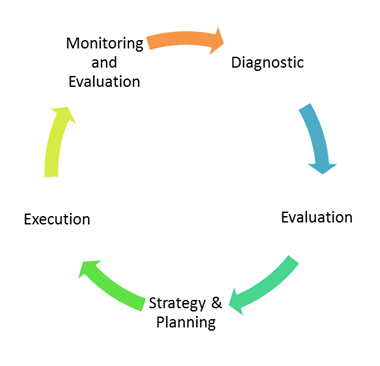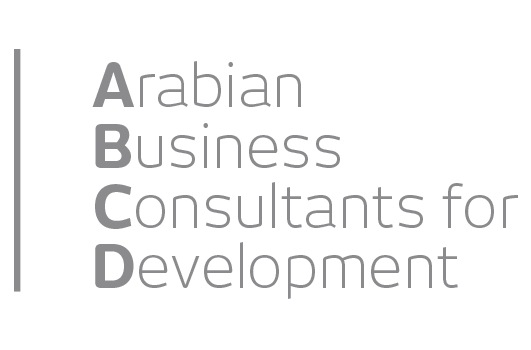Our Process
Arabian Business Consultants for Development provides clarity through structure and process as well as methodologies and tools to help its clients achieve their growth goals. In our initial meetings, we spend time listening, agreeing on and setting goals with our clients. We subsequently provide an assessment of the clients’ current position versus their optimal desired position, relative to their goals. We make recommendations on how best to move forward. Once the client has reviewed and agreed with the recommendations, we work with the client and the business teams to build a detailed implementation plan that will be executed by the client entrepreneur or business. We then provide periodic support and oversight to ensure efficient and effective implementation and help to address design and implementation issues as and when they arise.

The ABCD business process consists of the five following stages:
- Diagnostic: Identifying a client’s business needs engenders listening and asking the right questions. Diagnosis helps to determine the causes of symptoms, mitigations for problems and solutions to issues/challenges.
- Evaluation: Assessing the status, position and performance of a client’s business concept or functioning enterprise, using standardized criteria, helps to develop and gain insight into prior or existing actions/initiatives and enables reflection and informed planning for potential improvement.
- Strategy & Planning: Building a framework with an entrepreneur’s or a company’s top management on behalf of its owners, involving resources and performance in internal and external environments, is planning a strategy. Strategies entail making deliberate and decisive choices about where to integrate and the way to play- the strategic five: 1) business type, 2) target customers, 3) value proposition, 4) value-added product/service, 5) resources/capabilities). Planning a strategy also entails specifying the organization’s corporate five: 1) mission, 2) vision, 3) purpose, 4) goals, and 5) plans, often in terms of projects, programs and activities/tasks which are designed to achieve these objectives. Strategies also encompass allocating resources to implement the policies and plans, projects and programs. Key performance indicators (KPIs) are usually set at the strategy design stage to allow for effective monitoring of progress and evaluation of impact at any given point in the future.
| Strategic Issues What business should we be in?How is value added to the business?Who is the target market?What is a competitive value proposition for the target customer?What capabilities are essential to be competitive (i.e. add value and differentiate the business)? | Corporate Issues What does the company’s future look like? (Vision)What is the objective of the company (what does it do – Mission)?Why does your company exist (Purpose)?What set of tasks and activities will be undertaken within a specified time to achieve what you want (Plan)?How will you measure and evaluate progress against your stated Vision, Mission, Purpose and Plan (activities and tasks)? |
4. Execution: There are 4 Disciplines of Execution that constitute precise rules for translating strategy into action at all levels of an organization. When applied, the 4 Disciplines produce extraordinary results by tapping the desire to win that exists in every individual.
Discipline 1 – Focus: Prioritize issues in order of importance.
Discipline 2 – Leverage: Accomplish more with less time and less resources.
Discipline 3 – Engagement: Rise from authority-driven compliance to passion-driven commitment.
Discipline 4 – Accountability: Drive accountability and follow through, despite a whirlwind of competing priorities.
5. Monitoring & Evaluation (M&E): M&E is ideally understood as dialogue on development and its progress between all stakeholders. M&E is an embedded concept and an integral part of every project or program design.
In general, monitoring is essential to evaluation. During an evaluation, information from previous monitoring processes is used to understand the ways in which the project or program developed/progressed and stimulated the desired/targeted change. Monitoring focuses on the measurement of the following aspects of an intervention:
- Quantity and quality of the implemented activities (outputs: What do we do? How do we manage our activities?)
- Processes inherent to a project or program (outcomes: What were the effects /changes that occurred as a result of your intervention?)
- Processes external to an intervention (impact: Which broader, long-term effects were triggered by the implemented activities in combination with other environmental factors?)
- The evaluation process is an analysis or interpretation of the collected data which delves deeper into the relationships between the results of the project/program, the effects produced by the project/program and the overall impact of the project/program.


